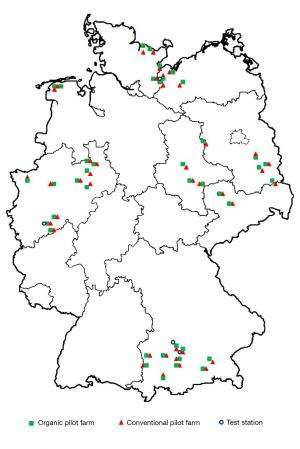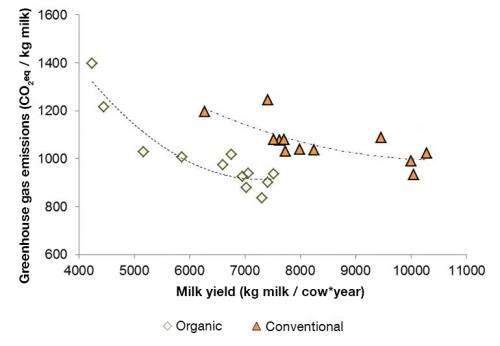This map shows the locations of pilot farms involved in the study. Credit: H. Frank/TUM
Agriculture is responsible for around 10 to 12 percent of all greenhouse gases attributable to human activities. This raises the question of how these emissions could be reduced. A recent study has investigated—for the first time—the full range of factors that contribute to greenhouse gas emissions, namely soil and climate conditions, the agricultural model and the farming intensity on both organic and conventional holdings.
The study has enabled scientists to develop a new model that will allow agricultural landholders to determine and improve their climate balance.
As part of the study, scientists investigated 40 organic and 40 conventional agricultural holdings across Germany's four agricultural regions. They focused exclusively on crop and dairy farms. The scientists recorded all relevant climate gas streams during the entire production process, including methane, nitrous oxide and carbon dioxide. In the case of dairy farms, they also factored in the purchase of soybean meal from South America and all related greenhouse gas emissions.
Strategies for improving climate balance
Fossil fuels, above all diesel, are one of the main sources of CO2 emissions in agriculture. However, greenhouse gases are also emitted during the manufacture of mineral nitrogen fertilizers and pesticides, agricultural machines and equipment.
Organic dairy farms produce 20 percent less climate gas emissions than conventional farms. Credit: H. Frank/TUM
"There are different ways of improving a farm's climate balance," explains Professor Kurt-Jürgen Hülsbergen from Technische Universität München (TUM). "One effective strategy is for landholders to grow feed themselves rather than purchase soy from another source. Farms can also streamline production processes and deploy modern technology to obtain higher yields without increasing the amount of energy required."
In crop farming, increasing nitrogen efficiency is a key factor. High levels of nitrous oxide are released into the environment if crops are unable to utilize all of the nitrogen fertilizer that was spread. The production of nitrogen fertilizer is also energy intensive, which further increases the climate balance of unused nitrogen.
In contrast, the greenhouse gas CO2 can be stored long term as humus in the soil, and thus eliminated from the climate balance. "This can be achieved by planting legumes as part of a diversified crop rotation strategy," explains Professor Gerold Rahmann at the Thünen Institute. "Using soil less intensively and applying organic fertilizer also helps."
Topping the charts: organic versus conventional farming
Organic farming is more energy efficient and produces less land-specific CO2 emissions. This advantage, however, is offset by the significantly lower yields achieved through organic farming practices. The pilot organic crop farms produce around twenty percent less emissions per yield unit than conventional holdings.
Organic dairy farms use more plant fodder grown on site and do not import soybean meal. This strategy pays off, according to Hülsbergen: "The pilot organic farms we looked at emit around 200 grams less CO2 per kilogram of milk than conventional farms with the same milk yield."
Most interestingly, the investigations show that yields and greenhouse gas emissions fluctuate significantly between different organic farms in some cases to an even greater extent than the fluctuations between organic and conventional holdings. This demonstrates that the individual know-how of farm managers plays an important role in the greenhouse gas balance and that there is significant potential for improvement at individual farms.
Putting theory into practice
This is the first time that a study has provided a 360-degree overview of climate-relevant factors impacting all emissions related to livestock and crop farming. "We have a workable model that will enable us to identify the causes of low energy efficiency and high greenhouse gas emissions," adds Hülsbergen. "We are now optimizing this model so that it can be used directly by climate change advisors in the agricultural sector."
Provided by Technical University Munich






















